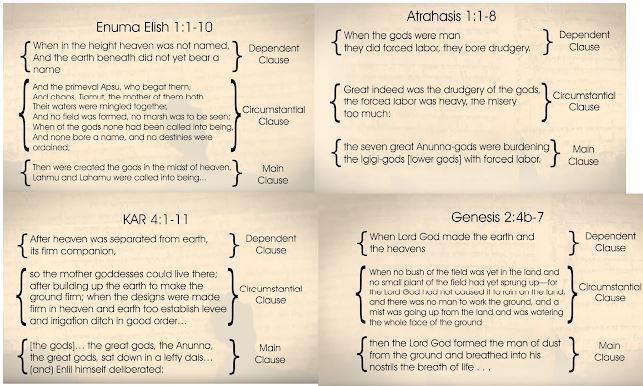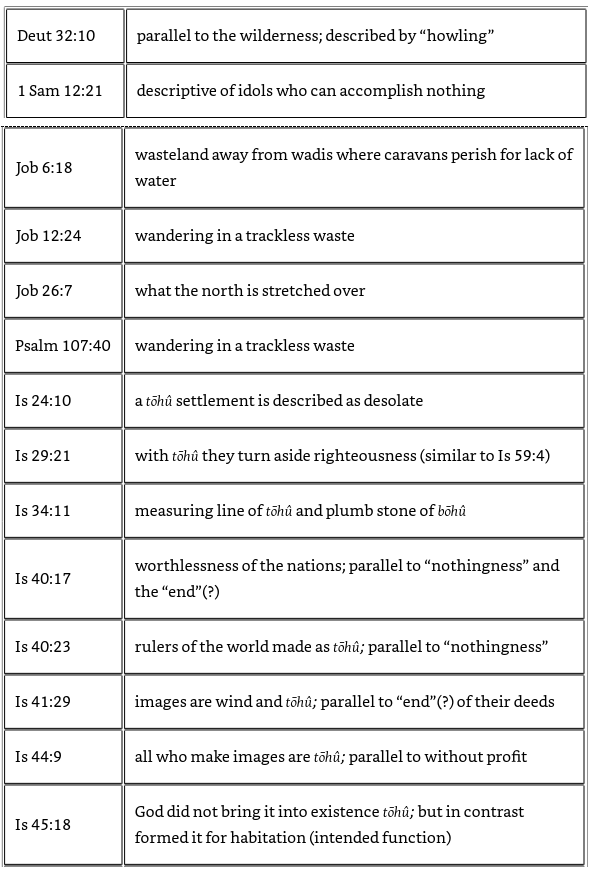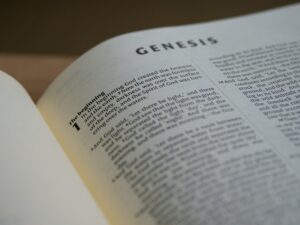Continuing my blog series on Genesis, I’ll today be evaluating another critic of The Cosmic Temple Inauguration Interpretation of Genesis 1, defended in John Walton’s “The Lost World Of Genesis One: Ancient Cosmology and The Origins Debate” and also in my blog post “The Cosmic Temple View Of Genesis One”. The article I’ll be responding to in this blog post is titled “Dubious and Dangerous Exposition: A review of The Lost World of Genesis One: Ancient Cosmology and the Origins Debate by John H. Walton” by Dominic Statham of Creation Ministries International (www.creation.com).
Statham begins with summarizing The Cosmic Temple Inauguration (CTI)view. “The first book of the Bible, he argues, does not provide an account of material origins, but functional origins. The ancients, he maintains, thought of existence in terms of function in society and culture, and, in their view, true existence is not even achieved until people and God are there to benefit from these functions (pp. 27, 36). The Genesis account, he claims, refers to a literal seven day period in history, sometime after the material creation, when God assigned the cosmos its real intended functions, prior to his taking up residence in it as his temple.
….On Day 1, God’s command, “let there be light”, and his “separating” light from darkness inaugurated temple time. The expanse (sky), ordained on Day 2, is established as the space in which his people live and would function in the new order to control rainfall and irrigation for their benefit. On Day 3, God “separated” the waters on the earth so that plants could grow on the dry land, providing us with food. On Day 4, the “lights in the sky” were dedicated as separators of day and night and markers of seasons, days and years. On Day 5, the roles of fish and birds are assigned their temple function, this being to fill the waters and fly in the sky. Similarly, on Day 6, the terrestrial creatures are ordained to reproduce and fill the land. Man is brought into being as a spiritual creature, carrying the image of God, and his function is established, to exercise dominion over the earth under God. Finally, on Day 7, God’s resting from his work should be understood as his taking up residence in the cosmos, thus making it his temple. Hence, the seven days refer to an inauguration ceremony where God’s temple is “created” and made functional (pp. 87–88).”
This summary is an accurate description of what The Cosmic Temple View (CTI) states. I see no misrepresentation in the summary description that Statham provided in the quote above.
Why It’s Called “The Lost World” Of Genesis One
In The Lost World Of Genesis One, John Walton says that the reason why the church hasn’t interpreted Genesis 1 as an account of functional origins inaugurating God’s cosmic temple is that the ANE thinking had been lost for a really long time. However, as archaeologists have found many Ancient Near Eastern texts (nearly a million Cuneiform texts alone), scholars have been able to study the literature and reconstruct the mindset of the Ancient Near Easterner. Walton says that through his study of Ancient Near Eastern beliefs, he has been able to correctly interpret the creation narrative.
Walton said:
“While this reading [Walton’s interpretation of Genesis] is initially based on observations of the biblical text … without an understanding of the ancient worldview, it would have been difficult to ask the questions that have led to this position and nearly impossible to provide the answers to the question that we have proposed” (p. 171).
In other words, we wouldn’t have questioned the presupposition that Genesis 1 was intended to convey natural history, a history of God materially manufacturing everything in the cosmos. Given that we can see a heavily functional oriented ontology in the various creation myths of the Ancient Near East, Walton and others have been prompted to go “Hmm…I wonder if Genesis is saying the same thing or if Genesis is departing from the standard way of thinking.” Once the cognitive environment of the ANE is established, the job is then to discover whether Genesis 1 follows the same kind of thinking or not.
Does Scripture Outside Of Genesis Falsify This View?
Statham says that in evaluating Walton’s interpretation, we need to follow the usual rules of hermeneutics. I agree. Statham says that we need to “let scripture interpret scripture”. I agree. All scripture is inspired by God (2 Timothy 3:16) and God will never contradict Himself since He is perfect and is the source of all truth. So, I agree that looking at other scriptural passages that touch upon a given subject can shed light on a passage that talks about that same subject. For example, if you find a Bible verse that appears to teach works-based soteriology, we need to look at that in light of Ephesians 2:8-9, Romans 4:1-8, Isaiah 64:6, and the entire book of Galatians. These passages overwhelmingly argue against the idea that we need to earn our salvation and strongly teach that salvation is a gift to be received.
So what scripture passages do Statham thinks argue against The Cosmic Temple Inauguration/Functional Creation view? He cites the following:
Isaiah 40:25, 26, God asks, “To whom will you compare me? Or who is my equal? … Lift your eyes and look to the heavens: who created all these?”
Isaiah 40:28 -“The Lord is the everlasting God, the Creator of the ends of the earth. He will not grow tired or weary, and his understanding no-one can fathom.”
Jeremiah 10:12 – “God made the earth by his power; he founded the world by his wisdom”. (Statham also refers the reader to Isaiah 42:5; Psalm 33:6, 9; Psalm 102:25 and others.
After listing all of these prooftexts, Statham says that “according to the Apostle Paul, God’s act of creation makes his power and divine nature plain so that unbelievers ‘are without excuse’ (Rom. 1:20, 25). The first verses of John’s Gospel are also particularly relevant here. ‘In the beginning’ is clearly a reference to Genesis 1, yet verse 3 speaks of the Word creating all things. And, again, in Col. 1:16, Christ is said to have created all ‘things in heaven and on earth, visible and invisible’.”
RESPONSE
Statham seems to think that Walton denies the doctrine of creation out of nothing, but Walton was clear that he does not. He certainly thinks God created all of physical reality out of nothing a finite time ago. He does not, nor do I, believe that the universe (matter, energy, space, and time) is co-eternal with God and that God just simply brought order within the cosmos. What we are contending is that Genesis 1 is not about that, and there are very good reasons why we should think that.
Michael Heiser wrote that “If you are dependent on your English Bible, you most likely think of the Bible in terms of verses. You need to realize the verses of the Bible are arbitrary and not part of the original text. We need to look at Gen. 1:1-3 the way a Hebrew grammarian does: as a set of clauses. In case you have tried to forget English grammar (or had poor English teachers) clauses are NOT the same as sentences (though the terms can overlap). For our purposes, a clause is a string of words that presents a single thought. The clause will often have a subject and a verb. (“The man ran”; man = subject; ran = verb) that together express the single thought. However, a clause may not have a noun subject (“Look out!”) and may not have a verb (“You jerk!”). All that matters is that a single thought is expressed. In the noun-less example, the subject is not stated, but a single thought is expressed: the speaker wants you or someone else to get out of the way. In the verb-less example, the single thought is that the person the speaker is speaking to is a jerk or is behaving like a jerk. …”1
Michael Heiser has argued that the Hebrew Masoretic vowel points and the wording of the Greek Septuagint do not imply that Genesis 1:1 should contain the phrase “In the beginning” because in the Hebrew, there is no definite article! Since there’s no definite article, Genesis 1:1 should be translated as “When” not “In the beginning”.2 “When God created the heavens and the earth.” This may appear to be a very inconsequential change at first glance, but simply by changing “in the beginning” to “when” causes a HUGE change of meaning in this verse and the verses that follow. What this means is that Genesis 1:1 is no longer an independent clause. It’s a dependent clause.
 |
| Slide taken from “Genesis 1: And God Said” by Inspiring Philosophy |
This makes verse 1 a dependent clause on verse 2, and it indicates that when God got to work in creating, the Earth was already there. This means that God doesn’t really start “creating” anything until verse 3.
 |
| Slide taken from “Genesis 1: And God Said” by Inspiring Philosophy |
Verse 1 of Genesis 1 is an independent clause, verse 2 is a circumstantial clause, and verse 3 is the main clause.
This formula was quite typically in the opening of the creation accounts of that era. You can see this exact same structure in the Enuma Elish, The Atrahasas, Kar 4, and the creation account of Adam and Eve (see the figure below).
 |
| Slide taken from “Genesis 1: And God Said” by Inspiring Philosophy |
Genesis 1:1 doesn’t imply an absolute beginning to all matter, energy, space, and time, but like other creation accounts of that time begin with the implications that there was an unspecified amount of chaotic time prior to the creation week.
Also, notice that material is already present in verse 2. In verse 2, we have the Earth, water, and darkness. The Spirit of God is hovering over the surface of the waters. Now, we have to ask; is this really what we would expect out of a material account of origins? Unlike what I used to believe, Genesis 1:1 is not a creative act like The Big Bang, no. God doesn’t start His creative activity until verse 3. So, what this means is that this creation account begins with the material already present. But if this were an account of material origins, wouldn’t it begin with no materials? I should think so! Instead, what we see is that the creation account begins with materials, but no functions.
 |
| Table is taken from “The Lost World Of Genesis 1” by John Walton, Kindle edition. |
The functional orientation of days 3 are 4 are overwhelmingly blatant. Moses wasn’t concerned with telling his reader how or when God made food and the sun, moon, and stars, he was concerned with why.
Finally, even if Isaiah 40:25-26, Isaiah 40:18, Jeremiah 10:12, Isaiah 42:5; Psalm 33:6, 9; and Psalm 102:25 were stating that God created the universe ex nihilo (which is debatable according to the way Bara can be used and the heavy functional focus of the ancients’ ontology), it would not necessarily mean that Genesis 1 is talking about the same kind of creation. When Genesis 1 begins with material already present but being described as unproductive and waste, and when an examination of the days yields a functional orientation time after time, the functional creation view of Genesis 1 becomes more likely than the material view. If Isaiah 40:25-26, Isaiah 40:18, Jeremiah 10:12, etc. were expressing that God is responsible for the material as well, that would merely supplement what we learned from Genesis 1. The later passages would inform us that God is responsible for the material as well as the functions. But again, what kind of creation Isaiah, Jeremiah, and the Psalmist had in mind is ambiguous from the grammar.
But Walton admits that Genesis 1 could theoretically be about both functions and material, but argues that since a functional focus is evident throughout the text, and that the ANE cognitive environment was dominantly functional, that Genesis 1 has a material focus alongside the functional focus has to be argued for. It cannot simply be assumed because that view of Genesis 1 is the one most familiar to us, modern westerners.
Moreover, there are some serious problems with viewing Genesis 1 about being functional. In The Lost World Of Genesis One, John Walton presents the following problems.
It is difficult to accept the idea that the vast majority of Christian and Jewish scholars have been wrong about the Bible’s account of creation for so many centuries.” —
This response is terrible. It doesn’t deal with the arguments in favor of the functional origins/temple inaguration view of Genesis 1! It just says “Well, Walton’s in a tiny minority here, so that means he must be wrong!” This is an obvious example of The Bandwagon or ad populum fallacy. Truth is not a vote. It doesn’t matter how many Old Testament scholars accept or reject CTI. What matters is where the evidence points. Ironically, Dominic Statham has no problem with the vast, VAST majority of scientists accepting Darwinian Evolution, but I’m guessing he wouldn’t take the nose count as evidence against young earth creationism. And rightly so, for a truth is a truth even if no one believes it and a lie is a lie even if everyone believes it. Listen to the arguments and avoid counting noses!
I also find it odd that he appeals to this James Barr quote. Barr doesn’t say anything about how many Old Testament scholars accept or reject a functional view of Genesis 1. Barr just says that they all agree that writer of Genesis intended the first 11 chapters to be a historical record and for the 7 days to be understood as 24 hour days. But this is not something I nor John Walton dispute.
That was fairly simple. For one, Genesis 1 depicts God as the sole creator of heavens and earth. No other deity is mentioned in the account. This is different from other creation texts in which a pantheon worked together to bring the world into being. Sometimes this occurred through sexual acts between the gods or even battles between then (theomachy), or through the gods coming into being themselves (theogony). But you don’t have any of that in Genesis. In Genesis, God declares what a thing’s function will be, and that is that. He doesn’t need to ask “Who do I need to screw to get something created around here?” or fight an opposing deity. He is ultimate. He is sovereign. This point is reinforced in later books of The Old Testament. Consider passages like Psalm 96:5 that says “For all the gods of the peoples are idols, But the LORD made the heavens.” and other passages exalting Yahweh over lesser elohim.
Also, many OT scholars have argued that some of the features in Genesis 1 were intended to spit in the eye of Israel’s neighbors, and their suggestions aren’t incompatible with CTI. For example, perhaps God didn’t mention the sun and moon until day 4 (and didn’t even call them by their names, just “greater light” and “lesser light”) to de-deify these entities which were considered gods by some of the surrounding cultures. Perhaps this why they aren’t mentioned with the function of time on day 1 that, as Genesis 1:14 says, the day and night were intended to carry out.
However, it should be noted that reconciling evolution with The Bible isn’t the motivation for adopting this interpretation. You can agree with CTI and be a Young Earth Creationist, Old Earth Creationist, Progressive Creationist, or Evolutionary Creationist. That CTI allows you to be free to follow the scientific evidence wherever it leads is simply icing on the cake.
The objections that Statham made in this section of his review are really irrelevant to whether or not CTI is the correct interpretation of Genesis 1. As I said in the subheader above, you can agree with CTI and be a Young Earth Creationist, Old Earth Creationist, Progressive Creationist, or Evolutionary Creationist. The CTI doesn’t commit you to any of these views. It leaves questions about material origins an open question.
“Some Pharisees came and tested him by asking, “Is it lawful for a man to divorce his wife?” 3 “What did Moses command you?” he replied. 4 They said, “Moses permitted a man to write a certificate of divorce and send her away.” 5 “It was because your hearts were hard that Moses wrote you this law,” Jesus replied. 6 “But at the beginning of creation God ‘made them male and female.’[a] 7 ‘For this reason a man will leave his father and mother and be united to his wife, 8 and the two will become one flesh.’ So they are no longer two, but one flesh. 9 Therefore what God has joined together, let no one separate.””
Looking at the verse in context, it’s obvious that Jesus was referring to “the beginning” of humanity, not the beginning of the universe. At the beginning of humanity, humanity was made male and female, and was intended to join together to become one flesh, never to separate. Marriage did not exist until humanity existed.
Space does not permit me to respond to Statham’s view that God would be cruel if he allowed millions of years of animal suffering and death prior to the fall in this particular post. I have addressed young earth creationist arguments against prefall death elsewhere (see, for example, my blog post “Why Pre-Fall Animal Death Isn’t a Problem For Old Earth Creationism”). However, all I’ll say here is that Statham, indeed all young earth creationists who make this argument, are totally inconsistent. Why do they have a moral complaint against a God who would allow animal death and suffering BEFORE the fall, but not AFTER the fall? Why is it somehow evil for God to allow bunnies to be eaten by wolves prior to Adam’s sin, but it’s perfectly ok for Him to allow it afterwards? What exactly is the difference here? A young earther might say in the comment section, “But muh Romans 5!”. However, I’m not addressing the biblical arguments against the preclusion of pre-fall death. I’m talking about the argument that only an immoral God would allow animal death pre-fall.
I highly doubt that David Hull would have his mind eased by simply saying “Oh well don’t worry, there was none of that nasty stuff happening until Adam sinned.”
For a quick blog post on the theodicy aspect of pre-fall animal death, check out J.B Stump’s article “Does Evolution Make The Problem Of Evil Harder?” and “Is Animal Suffering Part of God’s Good Creation?” on BioLogos.org.
Share this:
- Click to share on Facebook (Opens in new window) Facebook
- Click to share on X (Opens in new window) X
- Click to print (Opens in new window) Print
- Click to email a link to a friend (Opens in new window) Email
- Click to share on Pinterest (Opens in new window) Pinterest
- Click to share on Reddit (Opens in new window) Reddit
- Click to share on LinkedIn (Opens in new window) LinkedIn
- Click to share on Tumblr (Opens in new window) Tumblr
Discover more from Cerebral Faith
Subscribe to get the latest posts sent to your email.




